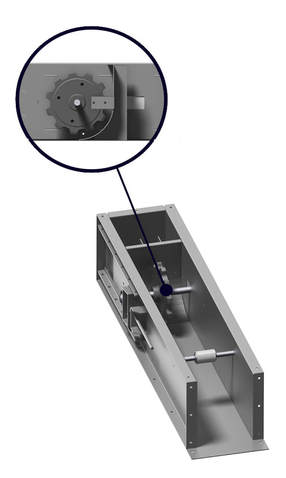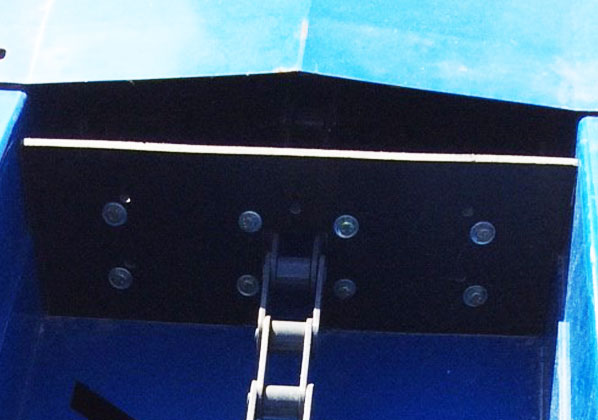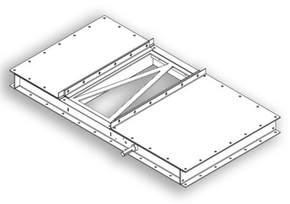|
Protecting product from cross-contamination is critical, especially when it comes to seed and pulse crops. Your conveyance is where the risk for contamination is usually at its highest. This necessitates constant clean-out measures that take up valuable time and are less than cost-effective. Here at Norstar, we believe that chain conveyance provides a well-balanced solution to the issue of cross-contamination and here’s why… A Self Cleaning Conveyor Cleaning out your conveyors is an often frustrating and time-consuming process. We designed our chain conveyors to minimize the amount of maintenance required. We did this in a number of ways.
Fully Enclosed Protection Norstar Chain Conveyors feature a fully-enclosed conveyor housing that effectively seals off the product from external elements. Our conveyor covers are bolted on and we utilize UHMW seals at the shafts to ensure moisture and dust do not make contact with the material being handled. A fully-enclosed conveyor housing negates the need for external dust control measures, keeping your site clean and prevent further contamination risk to other products within the area.
Conclusion
Keeping your product clean and pure is a key ingredient to your success. That is why we spend so much time figuring out how to best design a conveyor that better protects you from cross-contamination and that minimizes your clean-out maintenance. Choosing the right type of conveyance for your operation is critical to your success. In terms of operational efficiency, you need to be able to move your product quickly and with as low a cost as possible. In addition to moving your product efficiently, you must protect its quality and prevent damage along the way.
These two priorities; efficiency and product protection, may vary in level of importance depending on the application but they need to remain top-of-mind as you make your purchase decision. This is not an easy task, especially while being cost-conscious. There are four generally accepted forms of conveyance in the industry today; screw conveyance, belt conveyance, en-masse chain conveyance and incline chain conveyance. It is important to understand the pros and cons of each when planning your next move. Screw Conveyance – “From Point A to Point B” Screw conveyance is based upon the simple principal of material moved by the friction created by auger flighting rotating within an enclosed housing. It features a basic construction, with the auger flighting being the only moving part and is able to handle nearly any free flowing product out there. Because screw conveyors move material through sheer friction imposed by the flighting, the risk of damage to the product is high. This makes screw conveyance a poor choice for applications where product protection is of the highest priority (ie. Seeds, beans, etc.). This principal of friction also increases power and size requirements in order to achieve higher capacities which can be a limiting factor. Ultimately, screw conveyance provides a low-cost solution with its simple componentry and is a good option for commodities such as grain, feed and even fertilizer (with stainless steel construction) that do not need to be gently handled. It also offers versatility with the ability to convey under-bin, overhead or on-grade as well as both horizontally and vertically. Belt Conveyance – “A Gentle Touch” Belt conveyance is generally thought to provide the gentlest handling experience. With the material sitting on a belt as it moves along the conveyor, there is very little friction between material particles. This is why the belt conveyor is commonly seen in seed operations and other applications where maintaining the integrity of the product is the highest priority. Belt conveyance is a considerably more expensive form of conveyance when compared to screw augers and it can also come at a higher maintenance cost. Belt conveyors do not offer the most thorough cleanout as product can be left on the belt as it circles back or drop off to the conveyor floor below. This makes it necessary to regularly clean the conveyor in order to prevent cross-contamination when handling different varieties of material. Belt conveyors can also require a significant footprint which can be a challenge in situations with limited space. For a solution that protects against product damage for commodities such as seed or beans, belt conveyance offers excellent results. These results come at the expense of a higher initial investment as well as increased maintenance costs. En-Masse Chain Conveyance – “A Well-Rounded Solution” En-Masse chain conveyors are the most energy efficient form of conveyance on the market. En-masse conveyors transport material using a chain and paddle flight system. The shallow paddles (pulled by the chain) drag along the bottom of the conveyor which moves the material sitting in its path. The movement of the particles on the bottom of the conveyor also carry the particles above with them as well. There is minimal torque exerted in this process which translates to lower horsepower requirements. The minimal torque also means that there is less force experienced by the material being handled which helps minimize risk of product damage. The cost-savings with an En-Masse conveyor are found in the low-maintenance of the conveyor itself. UHMW paddles exert minimal damage to conveyor housing when compared to steel auger flighting. It is also easier to remove or add chain links to the conveyor chain than it is to cut and splice belting. En-Masse conveyors offer a cleaner throughput due to a fully open interior with no area for product to drop-off. Despite a higher initial cost, En-Masse conveyors provide a well-balanced mix of gentle handling, product containment and operational efficiency when handling a wide range of free-flowing materials. Incline Chain Conveyance – “Rising to the Challenge” Incline chain conveyors operate similar to En-Masse conveyors but with the purpose of transporting product at exceptional rates of incline (up to and over 45°). An Incline conveyor features taller paddles that allow for product to be conveyed at an angle without significant fallback. Unlike the En-Masse’s open interior, Incline conveyors feature a dividing plate within the conveyor that creates a conveying chamber as well as a return chamber to ensure that there is no conflicting torque during conveyance. Incline chain conveyors are designed as stationary conveyance solutions and do not provide an answer for applications that require a portable solution. They are intended and most often used for receiving applications. With the ability to handle almost any free-flowing material, Incline conveyors provide the best solution for stationary incline conveyance over short or long distances. Conclusion It is important to remember the above features and flaws of each conveyance method as you plan your site and decide which option that you will use. The efficiency of your operation and the quality of your product will be effected differently with each variation of equipment. These are not decisions that you will make lightly, but with a clear understanding of conveyance design and application you can streamline your systems and increase your bottom line. |
Archives
April 2020
CategoriesCOMING EVENTSGEAPS
Minneapolis, MN Date: March 21-24 Booth #: 2325 |





 RSS Feed
RSS Feed
7/31/2017
0 Comments